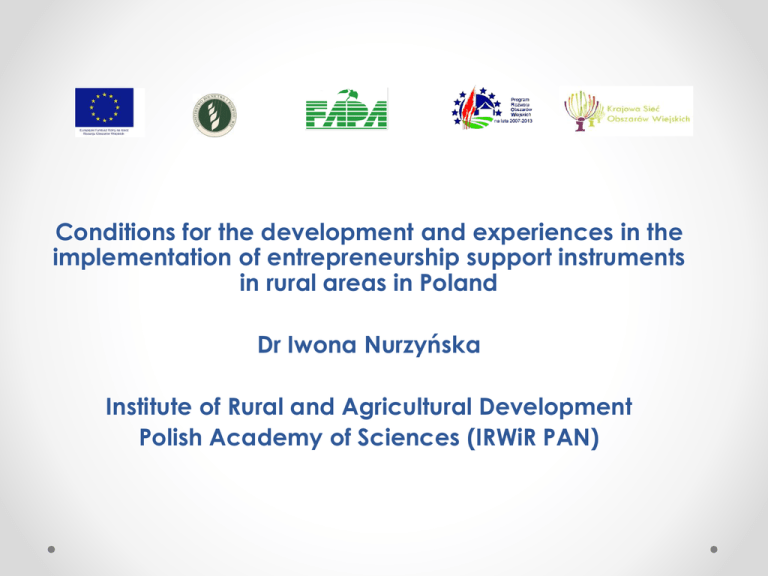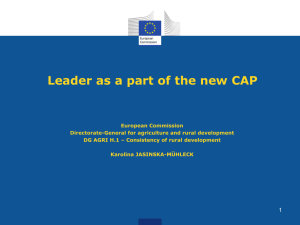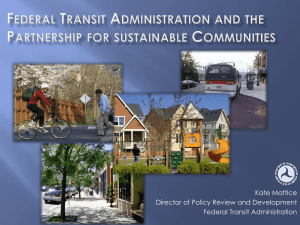Structure of the presentation - Flagship project Sustainable Rural
advertisement

Conditions for the development and experiences in the implementation of entrepreneurship support instruments in rural areas in Poland Dr Iwona Nurzyńska Institute of Rural and Agricultural Development Polish Academy of Sciences (IRWiR PAN) Structure of the presentation: 1. Rural and agricultural economy - need for off-farm jobs 2. Rural entrepreneurial ecosystem - strengths and weaknesses of rural areas as place to run a business 3. Barriers for the rural entrepreneurship development in Poland 4. Institutional system of the EU CAP implementation in Poland 5. EU support programs for job creation in rural areas 6. Lessons learnt Rural and agricultural economy in Poland Why do we need non-farm jobs in Poland? • • • • • • • • • Decreasing role of agriculture in the national economy – a 3,3% contribution to Poland’s GDP Agriculture as „a reservoir” of the labor force - still12,8% (2,0 million people in 2011) of the employed work in agriculture but the agricultural productivity accounts only for 30% of the EU27 average productivity (hidden unemployment Decreasing number of farms but only some 100-150 thou. competitive farms (> 30 ha and 16 ESU) Rural households income disparity – disposal income per capita in urban areas over 41% higher than in rural areas (2009) Unemployment among non-farming populationon in rural areas 12,9% Deagrarization - some 60% of rural population has no links with farming land and only 1/3 of rural population lives on agriculture Entrepreneurship index lower than in urban areas (only 25% of the registered enterprises in RAs) Depopulation of rural areas (migration of the young) and land abandonment Source: RDR 2012, FDPA, Nurzynska & Wilkin (editors) Farm structural change in Poland over 2002-2010 Years AUA [in thou. ha] Average [in ha] 2002 Agricultural holdings [in thou.] 2 933 16 899 5,76 2010 2 278 15 534 6,82 2010:2002 [in %] 77,6 91,9 118,4 Source: National agricultural census. 2010, GUS, Warszawa 2011 Number of farms in 19902010 by size (in ’000 ha) 1800 1600 1400 1200 1990 1996 2002 2010 1000 800 600 400 200 0 up 1ha 1-5 5-10 >10 10-20 20-30 30-50 >50 Socio-economic groups in rural areas % Employees of public sector Employees of private sector Farmers Retired and pensioners Private business Unemployed Non economically active (others than the unemployed) Students and pupils No data 7,1 15,5 7,9 22,5 2,3 4,6 16,5 21,6 2,1 Source: Halamska M. (2011), IRWiR PAN, based on Diagnoza społeczna 2009 Klasy oceny wg Jenks' Natural Breaks (udział klasy w zbiorze) korzystna (46%) przeciętna (25%) niekorzystna (29%) poglądowa granica rozbiorowa obszar miejski © Monika Stanny Weaknesses of rural entrepreneurial ecosystem 1. Low level of development of the local market: insufficient local demand resulting from lower rural households’ income (income disparity = ~40% ); 2. Difficult access to the final customer and users of services and products – lower population density; peripheral location 3. Lower qualifications and education level of rural people which limits the access to the qualified specialists (lower willingness to commute to rural areas for jobs); 4. Underdeveloped technical infrastructure compared to urban areas (roads, water supply and sewage system, energy and telecommunication networks - Internet), which implies higher costs for potential investors; 5. Hindered access to financial infrastructure in rural areas – difficulties to acquire capital for start ups Weaknesses of rural entrepreneurial ecosystem 6. Hindered access to training and advise for rural entrepreneurship development (often inadequacy of entrepreneurship support) 7. Underdeveloped entrepreneurship culture (attitudes, perception, roles); 8. Low level of social capital (trust, cooperation). 9. Lack of more targeted policies differentiated between potential entrepreneurs and existing enterprises. Strengths of RAs 1. Natural resources for the development of on-farm food processing (local, regional and traditional food) 2. Lower labor costs - access to relatively low-paid employees (key for start-ups) 3. Potentially easier access to investment areas 4. Informal human relations; 5. Individual and friendly approach of local public authorities 6. Dedicated EU-funded aid programs for rural areas Source: Institutional barriers for rural entrepreneurship development (2011), Nurzynska and others, EFRWP Rural entrepreneurship development barriers in Poland • Complicated, costly and implementation procedures; time-consuming regulations and • Inadequate regulations to the small and micro-enterprise scale of operation (Think Small First, KE); • Insufficient number of advise and training organizations (access) • „Overregulation” – not proportional to the problem addressed • Administrative barriers „red tape” (elimination regulations: one in – one out; sunset clauses) • of redundant Need for better educational system promoting „entrepreneurship” attitude and economic education Institutional framework of EU CAP support implementation in Poland The institutional structure of the institutions involved in the accreditation process of the Polish system of management and implementation of EU support MINISTRY OF FINANCE COMPETENT AUTHORITY CERTIFICATION UNIT MARD COORDINATION BODY Supervision over the operation EXTERNAL AUDITOR Examination of accreditation criteria for ARMA (PA) Source: Ex-post Evaluation of RDP. Final Report. MARD, Warsaw 2009. Accreditation issues Supervision over public spendings. Certification of accounts to the EC OTHER ENTITIES (DELEGATED BODIES) EU CAP budget transfers over 2004-2011 Transfers 2004 2005 2006 2007 2008 2009 2010 2011* 2004-2011 Market measure 10,7 166,7 181, 8 56,7 134,6 409,0 66,3 136, 6 1 162 ,7 RDP 662, 1 1 149,5 1 550, 8 846, 5 1 043,8 1 571, 9 1 385 8 496,5 Direct payment 0 702 ,6 811,5 545,3 1 037,6 1 446 ,1 1 827,7 2 392,4 8 763,6 Other transfers 10,6 11,1 400,3 12,4 14,86 12,5 2,9 286, 6 0 464,8 SAPARD 118 ,2 339 0,012 0 34,7 0 0 0 Total transfer 415,7 1 881,1 2 154, 1 2 553,3 2 065,9 2 913 ,9 3 478,6 3 917 492,1 19 379,8 Source: own calculations based on the data of Ministry of Finance EU Cohesion Policy and the CAP in Poland in 2007-2013 in MEUR 70,000.0 60,000.0 50,000.0 40,000.0 30,000.0 20,000.0 10,000.0 0.0 BE BG CZ DK DE EE IE EL ES FR IT CY LV LT LU HU MT NL AT PL PT RO SI EPS alokacje krajowe w mln euro w latach 2007-2013 SK FI ROW alokacje krajowe w latach 2007-2013 w mln euro SE UK EU-funded aid for rural job creation Program Measure Diversification of economic activities in rural areas Number of projects Payments/allocation* Share in the program budget in % 4 071 342,3 mln zł 6,75% 4015 282 mln zł 6% 21530 1380 mln zl* 2,00% 28670 4 092 mln zł* 5,90% n/a 450 mln euro (plan) 4,03% n/a ? ? SAPARD SOP Agriculture 2004-2006 RDP 2007-2013 RDP 2007-2013 RDP 2014-2020 (planning) PROW 2014-2020 (planning) Diversification of agriculural activities in rural areas Diversification towards nonfarm activities Creation and development of microenterprises Non-agricultural activieties in rural areas Support for existing SMEs (under LEADER budget – 5% of RDP) Polish RDP 2007-2013 (Share of Axes in %) RDP 2007-2013 Axis 3 Objective – improvement of quality of life and job creation in rural areas via: • Access to capital for start-ups and development of rural SMEs ; • Access to training and advise services; • Improvement of rural technical infrastructure; • Village renewal • Creation of support network for enterprises and local development (LEADER approach) Some business ideas under the measure „Establishment and development of micro-enterprises” of RDP 2007-2013: - - Hospital for horses, Wielkopolska region, 2 jobs Hotel modernization and equipment purchase „Dwór Korona Karkonoszy”, Dolnośląskie region, 2 jobs Polish-English artistic kindergarten, Małopolska region, 1 job Purchase of modern equipment (3D laser scanner with software), Świętokrzyskie region, 2 jobs Cosmetic and SPA services – expansion of existing business , Lubelskie region, 2 jobs Textile business expansion (purchase of machinery and transportation means), Pomorskie 2 jobs Rural sport and recreation center (Factory Fitness Club ) under LEADER, 1 job RDP 2007-2013 Job creation measures Measures Axies 3 Limit in MPLN Value of Relation of contracts contract Payments Payments Projects Contracts concluded value to done as % of submitted concluded in MPLN limit value MPLN the limit 311 1 428,5 28 999 15 045 1 329 91,47% 1 011,3 91,47% 312 4 232,5 45 450 11 738 1 624 29,60% 1 078,8 24,62% Total 5 661,0 74 449 22 698 2 953 52,10% 2 090,1 36,90% Source: own caculations based o the Ministry of agriculture weekly reports as of July 2013 Rural Development Program Off-farm jobs 2007-2013 Objective: off-farm jobs (start-ups, micro-firms creation and development, LEADER) Target groups: farmers and farmer family members, SMEs, Share in RDP budget: 7,9% 2014-2020 Objective: off-farm jobs (start-ups, existing SMEs support under LEADER) Target groups: farmers and farmer family members, existing SMEs (2 years), LAGs Share in RDP budget: 8,06% Conclusions: 1. More integrated approach towards programming of the EU funds (CSF 2014-2020) for job creation at regional level 2. Less money under RDP 2014-2020 for job creation 3. Need for domestic policy more targeted at job creation in rural areas. 4. Need for the complex entrepreneurial ecosystem – „tailored” composition of information sources, training and advice institutions supporting nascent entrepreneurs, suppliers of goods and services, local demand, technologies, financial support, access to external capital etc. 5. Role of NRDN (KSOW) in 2014-2020 Thank you for your attention





